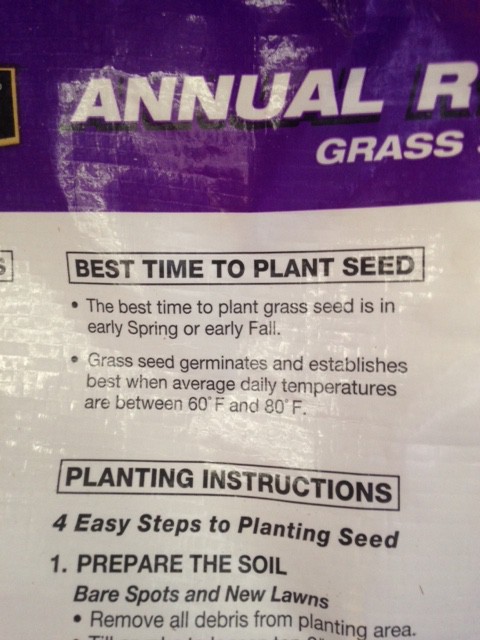
by Julie McConnell | Mar 2, 2016
Those familiar with the Florida-Friendly Landscaping™ Principles know that the number one rule is Right Plant, Right Place. But proper timing is important and should not be discounted! Experienced gardeners recognize that certain flowering and annual vegetable plants have distinctive seasons, but may not realize that turfgrass is seasonal, too.
Warm season and cool season turfgrasses fall into the classes of either annuals and perennials. In North Florida, the most commonly grown turfgrasses are warm season perennials such as Zoysiagrass, Bermudagrass, Centipedegrass, and St. Augustinegrass. These grasses thrive in warm weather and, although they may slow down or even turn brown in the winter, are still very much alive and resume growth readily in the spring. Because they are warm weather lovers, plan to seed one of these species when soil temperatures are warm enough for successful seed germination and when young new grass has enough time to become established without danger of frost damage.
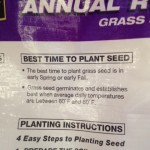
Annual ryegrass label says to plant early spring – but that is too late in North Florida. Photo: Julie McConnell, UF/IFAS
On the flip side there are cool season grasses such as fescue, ryegrass, and bluegrass. These grasses prefer cool weather and do poorly and may go dormant or die when subjected to hot weather. These grasses may be perennials in other areas of the country, but should be treated as cool season annuals if grown in Florida. Cool season grasses may be used as a groundcover in bare spots or to overseed warm season grass from fall through early spring.
When purchasing turfgrass seed, be sure to check with your local extension office to verify that the timing is right for that particular grass. Seed products sold locally may have recommendations that are more relevant to northern climates and performance will differ.
For more information about seeding lawns please read Establishing Your Florida Lawn
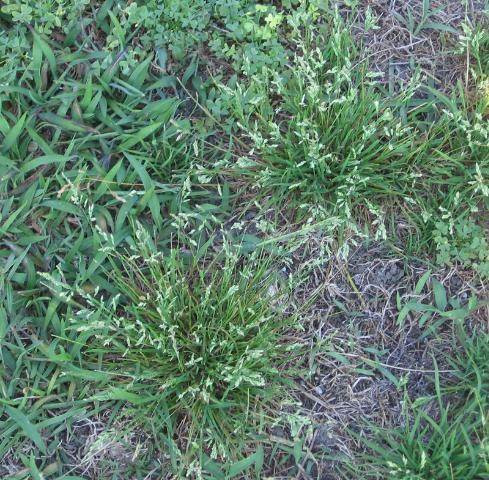
by Les Harrison | Feb 10, 2016
Weeds grow everywhere, especially in manicured lawns and landscapes despite the best efforts of owners who have spared no expense to remove the offending flora.
The reality, at least about the herbicides, is different from perceived appearances. Herbicides can be a wonderful tool for the homeowner, if applied properly.
The first point to remember about herbicides is to always, Always, ALWAYS apply them as instructed by the label directions. The oft quoted mantra of “the label is the law” is accurate.
Herbicides and their labeling are periodically reviewed and assessed to confirm effectiveness against target weeds without damaging the environment. Not following the label directions can have many negative implications for both the environment and the applicator.
Herbicides are either selective or non-selective when killing plants. Non-selective herbicides kill or damage every plant, but selective herbicides target a narrower range of plants.

Annual Bluegrass – Image Credit Larry Williams
Never apply herbicides when there is a breeze or wind. Herbicide drift can injure or destroy plants that are not the intended target.
High temperatures can contribute to the drift problem by volatizing some of the herbicide spray. Even the lightest air movement will cause drift off the target weeds when this condition exists. Herbicide drift can also be deposited in ponds and streams, harming the aquatic creatures that live there. Some herbicides are toxic to fish, insects and other animals that can be killed by tiny amounts of the active chemical. Additionally, the off target herbicides can kill aquatic plants. When the dead plants decay, they deplete the water of oxygen, again threatening or ending the life of the water’s residents.
Rain or dew resulting from high humidity can negate a herbicide’s application. If a leaf is wet, most or all the herbicide will run off on to the soil where it can leach into the water table.
Regular herbicides work only when the plant is actively growing. Pre-emergent suppresses the growth of the weed seedling above the soil level.
Many weeds have already produced seeds for next spring. Herbicides applied now will not affect the germination of that seed months from now.
The most effective strategy is to mow weeds before they set seed or to collect and destroy those which have already produced seed. Even with 100 percent success at eliminating this year’s weed seed crop, there will be weeds next year.
Some weed seed remain in the soil, sometimes for decades, only to germinate when conditions are perfect for their sprouting. Sickle pod and crotalaria are local examples of long term seed vigor.
Other seed can blow in or be dropped by wild or domestic animals passing through the property. A pre-emergent herbicide which stops germination can help control these latent invaders.
For more information:
Weed Management Guide for Florida Lawns
Chemical Weed Management

by Larry Williams | Feb 10, 2016
It

Image courtesy UF / IFAS Florida Friendly Landscaping
It’s too early to fertilize our warm-season lawn grasses now. This includes the use of fertilizers contained in weed-and-feed products.
There are a number of reasons why it’s best to wait to fertilize your lawn.
First, the soil temperature is too cool for grass roots to have access to some of the fertilizer elements. For example, iron and potassium are poorly available until the soil warms up in spring. Some nutrients leach below the grass roots because the lawn can’t use them yet. This results in waste of fertilizer, time and money.
Secondly, fertilizing too soon can induce nutrient deficiencies and off color areas in your lawn. This is one cause for bright yellow areas in lawns during early spring. Nitrogen is readily taken up by the lawn, even under cool soil conditions, and stimulates early green growth. Early lawn growth is dependent on iron also being readily available. However, iron is poorly available under the cool soil conditions of late winter and early spring. Therefore lawns turn yellow in areas due to an iron deficiency caused by an early fertilizer application. Many times, as soil temperatures warm during mid April and May, the iron becomes available and the lawn turns green. So why not avoid this scenario by waiting until mid April to fertilize your lawn?
It takes consistently warm night temperatures to allow the soil to become warm enough for best root growth and optimal uptake of fertilizer.
Thirdly, the young, tender grass roots that are beginning to grow in early spring are easily burned by the fertilizer.
Fourthly, fertilizing too early can stimulate early lawn growth, which is tender and easily injured by a late frost. The average date for our last killing frost is mid March.
Also, be very cautious about using weed-and-feed products that recommend a late winter application. These products are usually high in nitrogen, which will cause your lawn to begin growing too early. If you’re trying to control weeds, it’s best to apply your herbicides separately from fertilizer, anyway.
In North Florida, it’s best to wait until your lawn has completely greened up in spring before applying any fertilizer.
Waiting allows for more efficient use of the fertilizer. You will not injury you lawn by waiting to fertilize but you can certainly injure your lawn by fertilizing too early.
So, have patience, allow your lawn to green up on its own and then fertilize, even if it’s not until mid April or May.
by Matthew Orwat | Feb 9, 2016
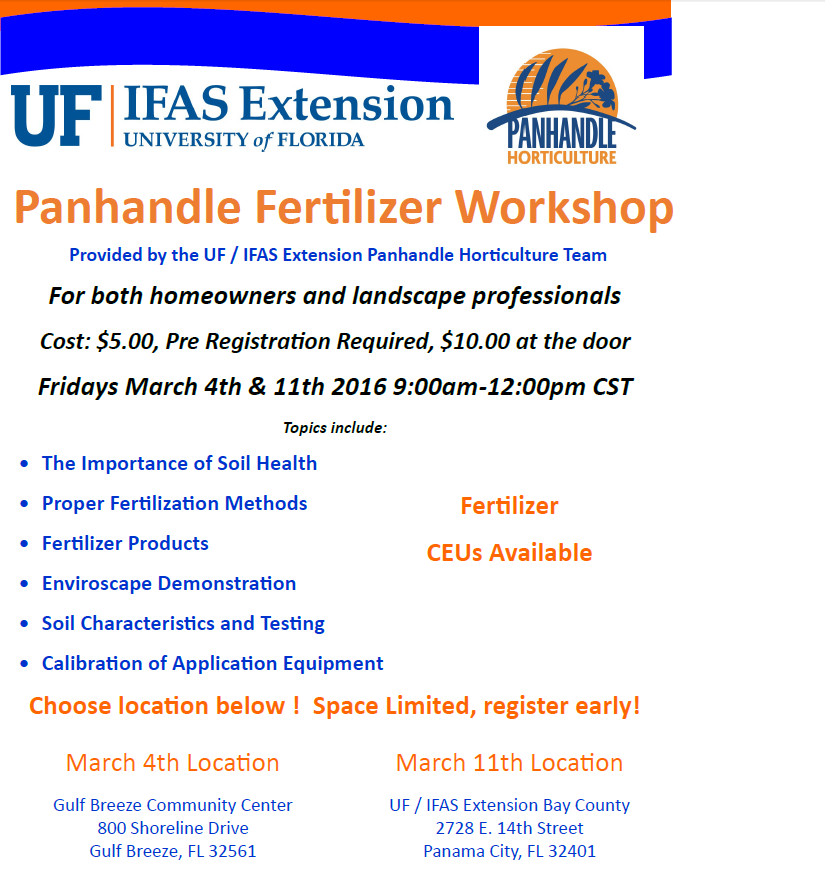
AGENDA
9:00-9:25 Opening Session: Introduction to lawn fertilization, when to fertilize and why proper timing is important, the importance of having a soil test
9:35-11:35 Four concurrent 25-minute sessions:
-
Soil profile example, soil texture example, soil test kits, soil test interpretation
-
Fertilizer spreader calibration
-
Fertilizer products for use on turf & landscapes
-
Enviroscape demonstration – Experience how fertilizers and other potential pollutants can contaminate our waterways
11:45-12:00 Closing Session – The importance of best management practices in fertilizer use
3 CEUs Available total : Urban Fertilizer (2), 482 Core (1) & Demonstration & Research (1)
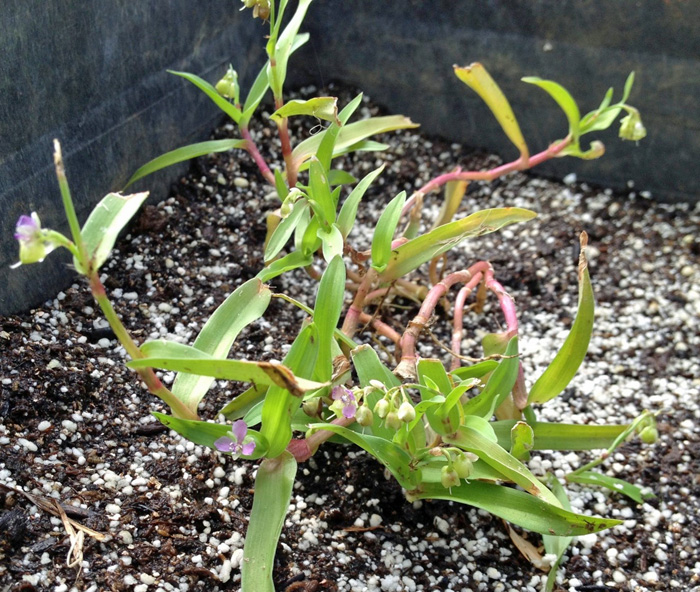
by Carrie Stevenson | Dec 4, 2015

______________________Figure 1. Doveweed patch in St. Augustinegrass sod.__________________________
Ramon Leon, WFREC Weed Specialist
Doveweed (Murdannia nudiflora) is a summer annual weed species that belongs to the dayflower family. Over the last three years, this weed has become an important weed problem in residential lawns and sod production.
This weed has two key characteristics that make it successful. First, its seeds germinate late during the spring when soil temperatures reach 65-70°F. This represents a problem because at this time the effect of preemergence (PRE) herbicides applied in February or March might be too low to provide good doveweed control. Second, the leaves of this weed can be confused with St. Augustinegrass and centipedegrass leaves, and many people do not notice doveweed until the plants are large and are displacing the turf. Doveweed leaves are thick with a shiny rubbery texture. The plant produces creeping stems (stolons), and mowers can break these stolons spreading this weed across the field.
It is very important to keep in mind that doveweed prefers wet areas, so drainage issues or over-watering will favor the establishment and growth of this weed. For this reason, ensuring irrigation is not excessive is a key management practice to control this problem. Another cultural practice that plays a major role on doveweed management is mowing. Mowing too short and too frequently will favor doveweed because its leaves will grow horizontally avoiding the mower blades. Chose a mowing height that allows good ground cover , yet only removes a third of the turf leaf blades.

___________Figure 2. Individual doveweed plant showing flowers, fruits, and stolons with root in nodes.________
Control
Doveweed is easier to control before emergence than when plants are well established. Atrazine is one of the most effective herbicides to control doveweed. A maximum rate of 1 lb. of active ingredient (ai) per acre (A) and no more than 2 lb. ai per year are recommended to achieve both adequate control and avoid turfgrass injury. Atrazine should be applied right before or soon after doveweed emerges to maximize control.
For PRE control, S-metolachlor (Pennant Magnum™), dimethenamid-P (Tower™), and indaziflam (Specticle™) are herbicides that can considerably reduce doveweed establishment, especially if the application is done closer to doveweed emergence timing. These herbicides also provide good control of other important weed species such as crabgrass and goosegrass, which emerge earlier in the spring. In order to control early emerging weeds and doveweed, split applications are preferred. For example, the first application is done at the end of February or early March and the second one 4 to 6 weeks after. In this way, we can extend PRE control until doveweed starts emerging.
If we observe doveweed emerging after PRE applications, we have several postemergence (POST) herbicides that will provide control, as long as the plants are less than 2 inches in size and have not produced stolons. Products containing 2,4-D and dicamba can provide fair control of doveweed. However, repeated applications or applications in combination with other herbicides will be required for adequate control. There are commercial products with formulations that combine 2,4-D or dicamba with other herbicides such as mecoprop-p, carfentrazone (Quicksilver™), thiencarbazone and iodosulfuron (e.g., Celsius™, Tribute Total™). This type of three− or four−way combination can provide enhanced doveweed control. If doveweed has fully displaced the turf in spots, it is probably easier and more effective to kill doveweed with a directed application of glyphosate (RoundUp™) and re-seed or re-sod the area.
Because doveweed seeds can live for several years in the soil, it will take two to three years of continuoous control to eliminate doveweed populations. Although herbicides are useful tools to control doveweed, the most important factor to prevent doveweed problems is to have vigorous healthy turf. Doveweed requires a lot of sunlight, so if the turf effectively shades the ground, doveweed will have a hard time growing and producing new seed.
For more information on managing turf weeds download:

by Matt Lollar | Sep 23, 2015
Armyworms come in a wide range of colors and sizes. A few of the prominent species living in Florida are beet, southern, and fall armyworms. And the term “living” is not an exaggeration, because Florida is one of the lucky states where it is warm enough for armyworms to overwinter. They are the snowbirds that never leave!

Armyworm damage on a lawn. Credit: Purdue University
Armyworms are notorious for unanticipated invasions. They feed on most turfgrass species and most vegetable crops, but they prefer grassy vegetable crops such as corn. Armyworms feed in large groups and their feeding has been described as “ground moving” in lawns. They feed during cooler times of the day (morning and evening) and they roll up and rest under the vegetative canopy (in the thatch layer in turf and in the base of leaves in vegetables) during the heat of the day.
Armyworms are difficult to control because of their spontaneity. However, in the lawn they hide in the thatch during the heat of the day. Over watering and fertilization can increase the amount of thatch. It is important to follow UF/IFAS guidelines for home lawn management. A good weed control program can also help to deter armyworms, because weeds serve as an alternate food source.
Numerous chemical control options are available, but softer chemicals such as horticultural oils and insecticides containing the bacteria Bacillus thuringiensis are recommended as a first line of defense. Insecticides should be applied in the morning or evening during feeding time. For additional control strategies and basic information please visit the UF/IFAS Armyworm Publication Page.

Armyworm feeding on a young corn plant. Credit: University of Illinois










